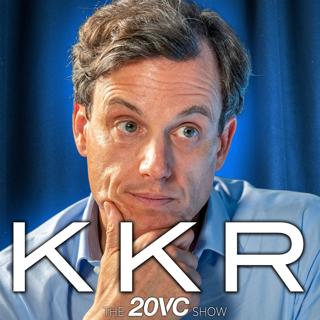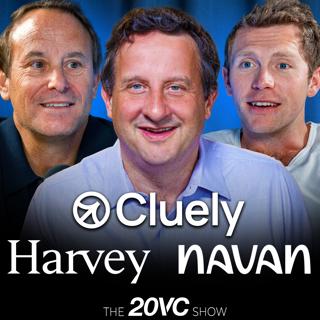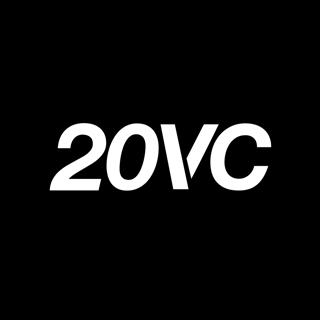
20VC: Vlad Tenev on Robinhood's $85BN Resurgence | Tokenizing SpaceX & OpenAI | Building Nine Revenue Lines Over $100M | Why Crypto Will Be Robinhood's Biggest Revenue Line | Why Stablecoins Will Replace Banking Rails
Vlad Tenev is the Founder and CEO of Robinhood, the greatest story on Wall St of the last decade. In the previous 18 months, Robinhood has increased its net revenue by 58% to nearly $3B; a $500M loss in 2023 turned into a $1.1B profit in 2024. Robinhood's stock is up roughly 4x, lifting their market cap to north of $80B. Today, Robinhood has nine lines of business that do over $100M in revenue. Agenda: 00:00 – "Tokenization Is The Biggest Innovation in Finance" 03:28 – How Robinhood 4x'd Its Market Cap in 8 Months 06:40 – AI Writes 50% of All Net New Code at Robinhood 10:02 – Why Robinhood Built a Secret ChatGPT for Support 12:11 – The One Customer Type That Transformed the Business 15:29 – "CoreWeave Is Retail's Way Into AI" — The Meme Stock Defense 18:05 – Inside Robinhood's Tokenized Private Shares Product 21:23 – "Capital as a Service" — Vlad's Wild Vision for Startup Fundraising 24:10 – The $100M Revenue Line Vlad Wishes He Could Kill 26:45 – Robinhood Is Building... Cash Delivery Trucks?! 29:55 – "We Were Shipping Nothing": Vlad on the 2020–2022 Culture Crisis 33:20 – What Line of Business Will Be the Biggest For Vlad in 5 Years Time 35:11 – The One Competitor Vlad Actually Respects 36:55 – From Men's Health to Japanese Toilets: Vlad's Weirdest Quickfire Yet 38:40 – "I Was in the Dumps": What 2022 Taught Vlad About Resilience 40:00 – Where Robinhood Is Headed: The Next Decade of Financial Infrastructure
14 Juli 57min

20Growth: The Death of Growth Teams? | How Hubspot Use AI to Triple Email Conversion | The Future of AI SEO | Why Prompt Engineering is the New Coding | What Every CMO Needs to Know About AI in 2025
Kieran Flanagan is the CMO at HubSpot, where he's led the transformation of their growth strategy from SEO-led to multi-channel and AI-powered. Formerly SVP of Marketing, he helped scale HubSpot's user base to millions and revenue past $2B. Before HubSpot, he drove breakout growth at Marketo and Salesforce. Kieran is one of the most respected voices in SaaS marketing and a pioneer in growth-driven content strategy. Agenda: 00:03 – The Death of Growth Teams? Kieran's Wild Prediction 06:44 – AI Innovation Pods: The New Org Structure for Startups 10:18 – Email Personalization That Tripled Conversions 13:21 – From Software Budget to Labor Budget: The Shift is Happening 16:35 – The Big Lie: Why Autonomous Agents Still Suck 19:24 – The Secret Sauce Behind HubSpot's Email AI Stack 21:44 – Segment-Based Marketing Is Dead. Enter Micro Audiences. 24:15 – Content Collapse: Why Google Organic Is Getting Torched 30:52 – The Future of AI SEO: 1 Product, 100 Pages, Infinite Prompts 33:16 – Memory = Moat: Why ChatGPT Is Becoming Unbeatable 35:46 – Prompt Engineering is the New Coding: Here's How to Win 41:03 – The Death of the Middle Manager Marketer 46:17 – OpenAI vs. Anthropic: Kieran's $400M Bet 48:00 – Europe Is Falling Behind: The Harsh Truth on Regulation 52:39 – CMO Playbook 2025: Micro-Audiences, Creator-Led, AI at Scale
11 Juli 1h 15min

20VC: Daniel Gross and Nat Friedman: Acquired by Meta | OpenAI's SBC Bombshell: More Stock Comp Than Revenue | Privat Equity is Back: Olo Bought for $2BN | Microsoft Lays Off 9,000 People: Is This Just the Start | Will Sequoia Part with Shaun Maguire
Agenda: [00:00] The AI Talent Crisis No One's Ready For [03:00] Daniel Gross and Nat Friedman: Why Two Legendary VCs Walked Away From $1B to Join Meta [12:00] Meta's AI Talent Magnet: Will It Actually Work? [15:00] Cursor Is Breaking the Market: Can Anyone Compete? [18:30] OpenAI's SBC Bombshell: More Stock Comp Than Revenue [22:00] CoreWeave's Power Play: Buying Their Landlords [26:00] Is Circle Next to Go Shopping with Meme Equity? [28:00] PE Is Back: The Olo Take-Private Explained [35:00] Why Triple, Triple, Double, Double Is No Longer Sexy [41:00] QSBS Hack: The Billionaire's Tax Loophole You're Missing [48:00] Microsoft's AI Layoffs: Salespeople Are Dead, Long Live Engineers [50:00] "If You Need a Week to Learn AI, You Should Be Fired" [53:00] Will Sequoia's Sean Maguire Be Pushed Out? Place Your Bets [57:00] Will There Be a Recession in 2025? Jason Bets $75K It's a No [1:00:00] Is Linda Yaccarino Still CEO of X by Year-End? [1:03:00] Circle and CoreWeave's Meme Rally: Real or Mirage?
10 Juli 1h 7min

20VC: Scott Galloway on Are Billionaires Happy & The Impact of Money on Psychology and Self-Worth | Becoming a Better Father & Husband | Why We Should Drink More and Not Work From Home | The Tinder Effect & How it Makes Young Men Radical
Scott Galloway is a Professor of Marketing at NYU Stern, where he's taught for over two decades. He's the founder of several successful companies, including L2 (acquired by Gartner for over $150M), Red Envelope, and Prophet. He's a New York Times bestselling author of four books on business and tech, and co-hosts the award-winning Pivot podcast. Galloway also serves on the boards of The New York Times Company and Panera, and his public talks have been viewed tens of millions of times globally. In Today's Episode We Discuss: 02:00 – How to Win in a New Economy of AI 06:00 – Should We Break Up Big Tech? 08:00 – Why Young People Have a Right to Be Angry? 11:00 – Why the Tax Code Is Rigged Against the Young 13:00 – Tax Changes That Would Make Young People Rich Again 17:00 – The Tinder Effect: Why Men Are Angry 20:00 – The Loneliness Epidemic in Men 23:00 – Remote Work & The Case for Alcohol 26:00 – Why Richer Families are Happier Families 30:00 – The Truth About Kids and Career 34:00 – Are Billionaires Happy? 38:00 – Becoming a Better Son, Father, Partner 46:00 – Behind the Persona: Who Scott Galloway Really Is
7 Juli 1h 10min

20VC: Figma's IPO: The Full Breakdown | Index Returns $3.5BN on Two Deals | Why Melio's $2.5BN Acquisition is "Discouraging" | Asana's New CEO and the Great Founder Exodus | Oracle's $30BN AI Deal and What it Means for Incumbents
AGENDA: 00:00 – $400B in AI CapEx: Rational Investment or Madness? 05:00 – Figma's IPO: Rule of 80, $1.5B in cash, 40% margins. Unreal. 08:00 – Adobe Screwed the Deal—Should They Have Just Bought Canva? 16:00 – Pay-to-Play Deals: Heroic Hail Mary or Guaranteed Write-Off? 21:30 – How Index Is Returning $3.5B on 2 Deals 24:00 – Melio's $2.5B Exit: Insane Growth… So Why Did They Sell?! 35:00 – Massive Penthouses and the Death of Focus: AI Founders Beware 39:00 – Chime, Anthropic, Menlo & The Art of Selling LPs the Future 41:00 – Couchbase Acquired: PE Buyers Are Back… Or Are They? 44:00 – Why No One's Buying These 9-Figure SaaS Zombies 48:00 – If You Didn't Grow from AI By June 30, You're Already Dead 53:00 – Superhuman vs The AI-Natives: Who Wins the Replatforming War? 54:30 – Oracle's $30B AI Deal: Larry Did It Before You Even Started 56:00 – Scale Is Dead. Long Live Surge. The AI Data War Gets Bloody. 01:01:00 – Asana CEO Move & the Great Founder Exodus of 2025 01:06:00 – Will Cluely's Founder Be a Billionaire by 2029? Place Your Bets
3 Juli 1h 11min

20VC: Inside KKR's Monster $8BN European Fund | The $500M Turkey Gamble That Went Wrong | Do Andreessen & General Catalyst Scare KKR? | Will AI Kill the PE Model? | Can The PE Model Survive without IPOs and Where is the Liquidity with Philip Freise
Philipp Freise is Co-Head of European Private Equity at KKR, where he manages the largest private fund in Europe with $8BN in the latest fund. Philip has led KKR's investments in FGS Global, Superstruct, Axel Springer SE, BMG Rights Management, Fotolia, GetYourGuide, GfK SE, Leonine, Mediawan SAS, Scout24 Switzerland and Trainline. Previously, Philip worked at McKinsey & Company in and co-founded Berlin-based VC firm Venturepark, Europe's first pan-European incubator. Agenda: 00:00 – "We Lost $500M in Turkey. Here's Why We'll Never Do It Again." 01:40 – Inside Europe's Biggest PE Fund: $8B of Pure Firepower 03:55 – The $100M Dot-Com Failure That Changed My Career 06:45 – Why Picking the Wrong VC Will Destroy Your Company 10:20 – KKR's $500M COVID Gamble: Genius or Insane? 12:35 – Why We Ignored the Market & Deployed 40% of Our Fund 15:55 – KKR's Ruthless Portfolio Discipline: Love Doesn't Matter 17:10 – Do Power Laws Apply in PE? Freise Destroys the Myth 18:45 – The Truth About Capital Intensity in the Age of AI 20:10 – Can AI Kill the PE Model? Here's What Philipp Says 26:00 – The Secret to Great Investment Decisions at KKR 32:40 – Why There's a $3T Liquidity Time Bomb in Venture 34:25 – The Death of IPOs? How KKR Exits Without Going Public 40:05 – Will KKR Europe Hit $20B? Freise's Bold Prediction 43:45 – Helsing, Space, and Defense: The New Age of DeepTech Bets 45:30 – Tariffs, China, and the Future of the German Car Empire 47:00 – Freise vs. Bitcoin: Will USD Still Rule in 10 Years? 48:15 – 4 Global Shocks Happening Right Now That You Need to Know 51:30 – KKR Missed Spotify AND Alibaba?! The Painful Stories 53:00 – Do Andreessen & General Catalyst Scare KKR? Freise Responds 54:30 – The One Metric That Will Define KKR's Next Decade
30 Juni 1h 1min

20Sales: How to Layer Enterprise Sales on PLG | How to Sell AI Tools To Enterprises That Are Scared | Should Reps Own Their Own Pipeline | Mistakes All Founders Make When Moving From Founder-Led to Rep-Led Sales with Kim Graves
Kim Graves is GM, Americas at Notion, where she oversees all Sales and Customer Success efforts across the region. She brings extensive experience in building and scaling high-performing sales organizations, most notably at Slack where she helped grow revenue from $6M to over $1.5B. In addition to her operational role, Kim serves as a founding partner at 20SALES, a GTM-focused VC firm, where she advises early-stage companies on scaling revenue and optimizing sales processes. Agenda: 07:00 – The Secret to Winning a Discount Conversation 09:30 – Notion's Wild New Sales Method: Mindsets Over Stages 12:00 – Why Great Sellers Never Talk Product Too Soon 14:00 – How Slack Avoided the Biggest PLG Trap of All 17:00 – The Fatal Mistake Founders Make Layering Sales on PLG 20:00 – The "Renaissance Reps" That Build Billion-Dollar Motions 23:00 – How to Spot True Grit in a Sales Hire (Without Asking Directly) 26:00 – The Case Study Test That Filters Out Bullshitters 30:00 – The Real Reason Most Reps Fail Onboarding 33:00 – Should Reps Own Their Own Pipeline? Kim's Take Is Clear 36:00 – Why Cold Calling Works in 2025 (And Nobody Does It) 39:00 – The Sales Team Audit: The REKS Framework That Changes Everything 43:00 – How to Avoid Hiring the Wrong Rep Under Pressure 45:00 – When Sales Feels Second Class: PLG vs Enterprise Tension 47:00 – The One Thing Reps Still Do That AI Will Obliterate 50:00 – AI Sales Tools: Why Every Startup Is Failing to Get It Right 53:00 – Will We Have More or Fewer Reps in 5 Years? 56:00 – Enterprises Are Scared of AI – Here's How You Break In Anyway 59:00 – Kim's Secret for Getting Past Gatekeepers and Fake Champions 1:09:00 – Kim's Hardest Phase at Slack and How She Survived It
27 Juni 1h 17min

20VC: Nat Friedman and Daniel Gross Bought with Zuck's $100BN AI Budget | Navan Files to Go Public and Canva Pulls the Brakes: Why and What Happens | Why Larry Ellison is the Smartest Man in Tech | Substance or Sizzle: What is Real and What is BS in AI
Agenda: 04:21 - The Meta Acquisition Bombshell: Nat Friedman & Daniel Gross Join Facebook?! 06:00 - Facebook's $100 Billion Gamble: Can Zuck Buy the Future? 09:27 - The "Magic Room" Theory: Why Only Insiders Get Billion-Dollar Paydays 11:27 - Is Loyalty Dead in Silicon Valley? The Great Talent Exodus 16:00 - Harvey's $5 Billion Valuation: Genius or Bubble? 19:00 - The AI Gold Rush: Can Software Really Eat Human Labor? 22:00 - The B2B Unicorn Dilemma: Are There Enough $100B Companies? 25:00 - IPO Mania: Why Navan, Canva, and Circle Are Shaking Up the Markets 29:00 - Meme Stocks & Market Madness: The Circle Rollercoaster 32:00 - Canva's Billion-Dollar Question: Why Stay Private? 36:00 - Larry Ellison's Power Play: How to Buy Back Your Own Empire 39:00 - The Sales Tech Revolution: Why "Cheating" Tools Are the Next Big Thing 42:00 - Slack Lockdown: Is B2B Software About to Get Ugly? 45:00 - The Ultimate Quickfire: Will Trump Launch a Smartphone? Will the US Seize AI?
26 Juni 1h 13min






















